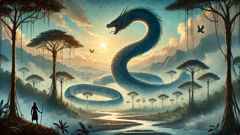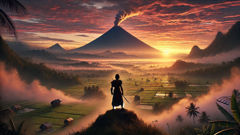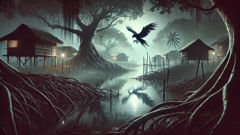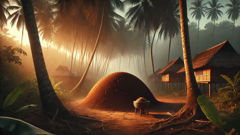Introduction
Before rivers knew their mouths and before mountains remembered their peaks, the world that the Kayan call home was a different sort of quiet—a soft and patient silence that sat in the belly of the forest and listened. In that first time there was no village smoke, no carved house posts, no songs to call the spirits. Instead there was a long breathing beneath the leaves, a low, slow movement that threaded through every root and reed. The elders say it was the breath of a great snake, older than the oldest tree, whose coils were so wide that birds nested in their shadows and whose eyes held the memory of the first rains. This serpent—neither only river nor only mountain—wound through the emptiness like a thought trying to become a world. When it stirred, water pooled at its scales and lantern-fish blinked awake; when it raised its head the sky took note and clouds gathered like curious children. The people of the river say the serpent was named Ngarung, though names can be many and change with the telling; whatever name you give, the story walks the same path: the world as we know it came not from a single word or a single hand, but from a body that gave itself away, piece by generous piece, until every island, stream, grove and hill fit together like the scales of a garment. Listen then, as the old voices teach us, to a creation that moves in spirals, that knows grief and grace, that leaves in every boulder and bend of river a trace of a long, living thing.
When the Serpent Stretched: The Forming of Land and Water
There was a time when the world was a plain of possibility and the creature Ngarung was the only presence that kept watch. Imagine an emptiness without the sharpness of edge or the comfort of home: no banks to a river, no slope to a hill, only the soft, unshaped skin of the earth. The story begins with a single stretch. Ngarung exhaled, and the breath became mist—thin at first, then gathering into clouds that courted the high hollows of the sky and eventually eased into rain. With each exhale the serpent turned, and water chased the folds of its body. The rain fell along its sides and pooled in the low ribs of its back, and where the water accumulated, it found a path downward. Those paths cooled and widened into channels. The first rivers were not carved by wind or stone so much as adopted from the windings of a living spine.

From the curve of a single coil, an arm of water slipped free and mapped a slow migration through the lowlands. The Kayan elders recite names for the first streams as if they are kin—names like Sungai-Mata and Tali-Ulung—names that hold a sound of gratitude. Where the serpent rested its belly, soil gathered and compacted like memory pressing into muscle. That settling became the first banks, and the banks became the first places where plants dared to root. Sedges took hold, then reeds, then a chorus of rootlings that clung to the wet edges. In this way the world was given grooves and edges not by decree but by the gentle insistence of movement.
One of the oldest remembered acts in the tale is when the serpent rose to look at the sky and the light of its eyes split across the land. In that gaze, shadows hardened into rocks. The scales along its back flaked with luminous dust that, as it fell, folded into ridges and hills. A mountain was born where a single scale dropped and rested, heavy and patient. Another ridge sprouted from a clump where the serpent slept for a long season, and the sleep itself soaked into the ground until it grew a valley. The Kayan people know these places by touch and by story: the place where Ngarung exhaled is a marsh; the place where it expelled a scale is a peak; the place where it coiled tight became an island. The pattern is not random but familial—the land resembles the creature that formed it, and the creature’s memory lives in every contour.
Creatures followed the new water as children follow a parent's path. Fish slipped into the newborn rivers like curiosities trying on a new home, frogs claimed the wet margins, and insects came as a restless shiver that quickened the air. Alongside these small lives, larger shapes came from the serpent's generosity: mud hardened into flats where crabs learned to climb; a slow drift of earth became a plain threaded with termite towers; vines found purchase on the wet ridges and grew like braids along the serpent's fallen scales. The Kayan say that the first human was not molded from clay by a jealous god but gently placed on a bank, near a spread of water where the serpent’s breath had kept the air cool and brimmed with life. They were told how the first humans learned to listen: to the river that remembers, to the stones that keep secrets, to the trees that groan like old drums. From listening came knowing, and from knowing came care: the first people learned to fish in ways that did not empty the stream, to tend the terraces where soil was thin, and to call to the spirits that lingered in the serpentine curvatures of the new world.
But creation is never only blessing; it holds a compromise. When Ngarung moved to give, it also left empty places—pits and hollows where its innards had been lighter, and these became pools where sometimes water did not linger. From those dry hollows grew a different kind of life: hardy grasses, shrubs with bitter sap, and fox-like animals that scavenged between the water and the forest. The Kayan speak of both the bounty and the scarcity born of the serpent's body. They teach that to live under the gift of such a creature is to accept both abundance and lack, to know that rivers will bring food but can also flood, that mountains protect and hide, that islands give refuge but sometimes limit passage. In this way their lore becomes a map not merely of place but of the responsibilities of living in a world made by a being who is both generous and indifferent.
Spirits, Songs, and the Promise of Care: How People Learned the Land
As the land settled into place, it carried with it not only physical features but voices. In Kayan telling, every place shaped by Ngarung kept a pocket of the serpent's spirit: a spring might carry the echo of a scale’s chill; a cavern, the low, dreamlike currents of its belly. The first people who came to the banks found these echoes like companions. They were taught, through nights of listening under constellations that were still learning their order, to name the places they lived in language that fit the land's memory. Through names they claimed a relationship—a promise to speak for the river when it swelled, to speak for the mountain when mist hid its face. This promise is central to the myth: people did not own the land; they entered into an agreement with it and with the leftover breath of the serpent.

To maintain that agreement the elders tell of the first songs. These songs were not mere ornament; they were patterned speech that stitched the human world to the serpentine memory. When a child was born near a bend of river, a song would be taught that mentioned the coil where the child’s cradle rested, the tree that shaded it, the first fish that fed the newborn's family. The songs named danger and sustenance, times of flood and times of blessing. They were also a ledger: to sing a place's name was to recall the debts owed—leaving fish, tending a particular grove, avoiding ground where shells of scales might still sit exposed. The singing was a kind of stewardship, a way to keep the world and its creatures in balance.
Parts of the myth are tender and slow. One beloved story tells of a woman who discovered a small scale half-buried in clay. When she took it home, her garden prospered, but only while she tended the scale with care—washing it in river water each new moon, placing rice offerings upon it, and singing the scales' old tune. When she became complacent, forgetting the washing and the song, the garden faded until she returned to the ritual and restored the balance. The tale is gentle in its lesson: reciprocity keeps the world healthy; forgetfulness invites decline. In living memory this became practice. The Kayan learned to harvest sago and fish with restraint, to rotate gardens, and to preserve patches of forest as places of spirits and song. Their tool-making and house-building would honor the contours of the land; rafters follow the grain of fallen trees, posts are carved with patterns that echo river swirls, and many houses have a corner left unswept for the unseen guests who came from the serpent's breath.
Not all stories end in agreement. There are episodes where human desire stretched too far. Once, an ambitious group attempted to reshape a bend of the river for larger harvests, digging deep and straight where Ngarung had left a gentle curve. The river resisted, returning in storm to undo their works and leaving the fields sodden for many seasons. The elders say this is the world reminding its children that force cannot trick the memory of a living earth. From these cautions came a deeper humility: rituals to ask permission before clearing land, offerings before fishing in the deep pools, and the careful marking of taboo sites where the serpent's coil ran nearest to the surface. The approach was not fearful but respectful; it acknowledged that the world remembers and that memory has claims upon those who live within it.
Beyond practical laws, the myth gives the Kayan a grammar for grief and for wonder. When someone dies, they are often said to return to the folds of the great serpent, or to walk along its back toward the sea where scales become islands. Funerary songs ask the serpent to hold the traveler gently, to let them warm against the old body at night. Birth songs ask the serpent for blessings of river-bread and patient soil. Even everyday laughter is framed as part of the pact: enjoying the bounty is permitted so long as the people continue to sing the land back into being. The myth, then, is a living contract, a way of placing humans among other living things without claiming absolute mastery. It is an ethic learned in the listening bands of river-banks and by the slow, disciplined repetition of songs that keep memory tuned to the land’s needs.
Conclusion
In the telling that is handed down by the Kayan, creation is not a single dramatic act but a gradual translation of presence into place: a living being giving itself to become the enduring features of a world. The serpent—Ngarung—keeps a visible memory in every river bend and rocky rise; the people keep a living memory in their songs, names, and rituals. Together they form a reciprocal chain: land begets song, song begets careful use, and careful use sustains land. When modern voices speak of conservation and indigenous stewardship, they often rediscover what has been practiced for generations along the rivers of Borneo: an ethic shaped by origin story, where landscape and life are interwoven parts of a single creature’s long exhale. This myth asks us to slow down, to listen to the banks, to recognize that places carry histories in their stones and that people in turn carry responsibility. If we accept that the world can be a body that remembers, then our work is to honor its memories, to sing back what was given, and to walk gently on the scales left behind.













